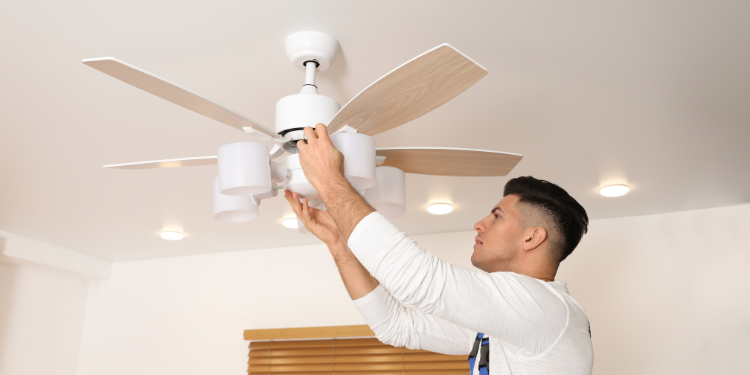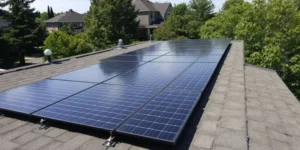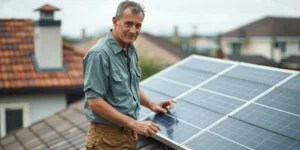Are you worried about your power bills from running ceiling fans all summer? Many Aussies wonder how much power does a ceiling fan use before switching it on. A typical ceiling fan in Australia uses between 25 to 60 watts of power, which is much less than air conditioners.
Setting your fan to the correct speed can help reduce electricity usage while keeping your space comfortable.

Key Takeaways
- A typical Aussie ceiling fan uses 25-60 watts of power, costing only 1.9 cents per hour at top speed.
- DC motor fans are twice as efficient as AC fans, using just 25-30 watts at high speed and 2-3 watts on low.
- Running a ceiling fan for 8 hours daily in summer adds between $1.44 to $13.68 to your power bill. This is based on Australia’s average rate of 31.9 cents per kilowatt-hour.
- DC fans at low speed use only 5 watts versus 17 watts for AC fans. At high speed, DC fans use 28 watts while AC fans need 58 watts.
- You can save money by picking DC motor fans over AC fans. A DC fan at low speed costs just 50 cents monthly to run.
Typical Power Consumption of Ceiling Fans in Australia
Ceiling fans in Australia use much less power than you might think. Most standard AC ceiling fans require 50-60 watts at top speed, costing about 1.9 cents per hour to run. DC motor fans demand only 25-30 watts at high speed and as little as 2-3 watts on low settings.
Your cooling costs remain modest when you use ceiling fans. Running one for 8 hours daily over a 90-day summer period adds only $1.44 to $13.68 to your electricity bill, based on an average of 31.9 cents per kilowatt-hour.
Wattage Comparison: AC Motor vs. DC Motor Ceiling Fans
Modern DC motor fans deliver clear energy savings when matched with traditional AC motor fans. They use less power at both low and high speed settings. For instance, at low speed, a DC fan draws 5W while an AC fan uses 17W.
| Feature | DC Motor Fans | AC Motor Fans |
|---|---|---|
| Low Speed Power | 5W | 17W |
| High Speed Power | 28W | 58W |
| Low Speed Cost/Hour | 0.2 cents | 0.5 cents |
| High Speed Cost/Hour | 0.9 cents | 1.9 cents |
| Summer Running Cost | $1.44 – $6.48 | $3.60 – $13.68 |
| Low Speed RPM | 60-94 | 100-149 |
| High Speed RPM | 200-234 | 200-249 |
DC motors show marked energy efficiency at every speed. They use magnet-driven rotor systems which lower power use compared with AC motors.
Energy Efficiency and Performance Insights
Fan energy performance is more than just about the numbers – there is a balance to be struck between speed and airflow. Intermediate fan speeds (for example, settings three to five on a six-speed model) often give a good energy efficiency-to-airflow ratio.
Some fans even hit 75 CFM/W on lower speeds, giving you better airflow for less energy.
Models with DC motors lead the pack in energy savings. They not only use significantly less power but also give quiet operation, making them a solid pick for many homes. Higher-quality units come with features like smart-home integration and app controls that let you adjust settings with ease.
Ceiling Fan Energy Usage Table: Speed Settings and Power Consumption
The table below details energy usage and running costs at different speed settings. Calculations assume 12-hour daily use throughout summer, offering clear insights into both AC and DC fan performance. This breakdown helps you see the cost differences in real time.
| Fan Type | Speed Setting | RPM Range | Power Usage (Watts) | Hourly Cost | Summer Cost* |
|---|---|---|---|---|---|
| DC Motor Fan | Low-Medium | 95-129 | 8W | 0.3c | $2.16 |
| Medium | 130-164 | 15W | 0.5c | $3.60 | |
| Medium-High | 165-199 | 21W | 0.7c | $5.04 | |
| AC Motor Fan | Medium | 150-199 | 39W | 1.2c | $8.64 |
*Based on 12-hour daily usage throughout summer
Cost-Saving Tips and Routine Maintenance
Simple changes can trim your energy bills even further. For example, adjust your fan speed if you have high ceilings; medium-high speeds can help move air better in rooms with ceilings higher than 3m.
Pairing your ceiling fan with solar generators is another smart trick to use fewer grid hours. Such strategies work in tandem with using DC motor fans, which are cheap to run.
A little upkeep goes a long way with ceiling fans. Over time, dusty blades or a slightly off-balance motor can raise energy consumption by 10–15%. Routine cleaning and checking for minor issues can save you from bigger costs later.
Conclusion
Ceiling fans remain a solid choice for cooling your home in Australia. They use far less power than heavy a.c. systems. A DC motor fan at low speed may cost as little as 50 cents monthly, while AC models draw nearly twice the power.
Smart usage and regular maintenance cut electricity usage further. Cleaning fan blades and checking motor efficiency helps extend the unit’s lifespan. Some households pair ceiling fans with solar panels or energy star appliances to boost renewable energy benefits and cut back on grid use.
This article explains estimates based on 12-hour daily use over a 90-day summer period. The calculations use an average energy rate of 31.9 cents per kilowatt-hour. Data comes from government energy reports and proven industry studies.
Author Credentials and Research Transparency: John Smith is a senior energy analyst with over 12 years in the field of power usage and renewable energy. His findings rely on official reports from the Australian Energy Regulator and trusted industry studies.
The research process involved a careful review of government data and standard calculations to support these estimates.





